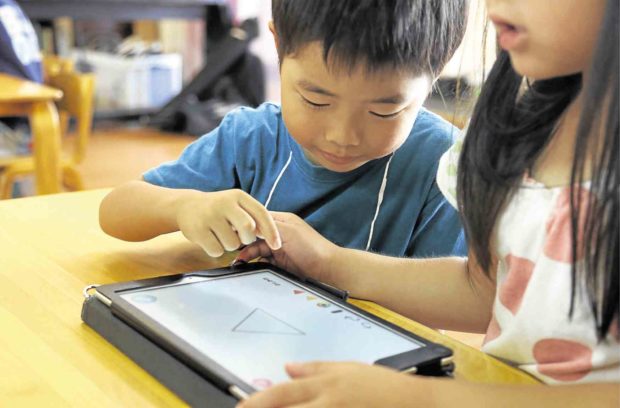Japan kids give up crayons for iPads

STARTING ’EM YOUNG Using iPads, Japanese preschoolers color birds and flowers that appear to come alive as three-dimensional computer graphics. They also draw various creatures that when captured as computer images, swim or float around in virtual landscapes. —AP
YOSHIKAWA, Japan — It’s drawing time at this suburban nursery school in Japan, but instead of crayons, tiny fingers are tapping on colors on iPad screens and taking selfies.
Digital schooling has arrived in this nation long known for its zealous commitment to “three R’s” education.
Coby Preschool, located in a small town northeast of Tokyo, is among nearly 400 kindergartens and nursery schools in Japan that are using smartphone software applications designed especially for preschoolers called KitS.
That’s only about 1 percent of this nation’s kindergartens and nursery schools. But it’s a start. Coby is helping lead a national initiative in “digital play.”
Parents everywhere worry their children might fall behind, and Japan is no exception.
Article continues after this advertisementThe government has recently made strengthening technology education national policy even as it struggles to meet its goal of supplying one digital device—computer or tablet—for every three children.
Article continues after this advertisementDigital play
With KitS, developed by Tokyo-based startup SmartEducation, children color birds and flowers that appear to come alive as three-dimensional computer graphics.
Children also draw various creatures that, when captured as computer images, swim or float around in virtual landscapes.
In a recent session, children got a triangle image on their iPads and were asked to draw on it with digital colors, store that image, and draw another one to create a two-screen story.
The usually shy children burst into an uproar, brainstorming happily about what the triangle might represent: a sandwich, a rice ball, a dolphin, a roof, a mountain.
The children were then encouraged to come to the front of the class and explain what they had drawn as the images were shown on a large screen.
Nurturing creativity
“There is no right or wrong answer,” said Akihito Minabe, the preschool principal leading the session.
The point is to nurture creativity, focus and leadership skills.
“They think on their own, they learn it’s OK to think freely, and it’s fun to come up with ideas,” Minabe said.
In the United States, 98 percent of children age 8 and under have a mobile device in their homes, while 43 percent have their own tablet, according to The Genius of Play, a US program that researches education and play.
That’s similar to Japan, where each adult has an average of more than one smartphone and about half of preschoolers have access to a mobile device, according to Japanese government data.
In many US, Asian and European preschools and elementary schools, teachers use technology to present stories, music and other information.
Educators are also studying children’s social development through how they learn to share digital devices.
Getting smarter?
Much of what’s driving the adoption of tablets in US preschools is a belief, founded or not, that an early start will make kids smarter at technology, according to Patricia Cantor, a professor of early childhood education at Plymouth State University in New Hampshire.
However, early research into how tablets and apps affect learning for kids ages 2 to 5 is inconclusive.
“Touchscreen stuff is pretty intuitive. They don’t need training,” Cantor said.
Some studies show positive outcomes among young children using mobile devices to improve their literacy, science or math skills, but there’s little research comparing tablet-assisted learning to more conventional teaching approaches, according to a review of 19 studies by Christothea Herodotou, a lecturer at The Open University in the United Kingdom.
Herodotou said it was still unclear which features might help or hinder learning.
Devices and apps can also be misused—for instance, to keep children occupied so teachers can do other things.
“Even if it’s designed to encourage learning or exploration or curiosity, it may not be used in that way,” Cantor said. “There’s so much junk out there.”
Still, the target age for “digital play” is getting ever younger.